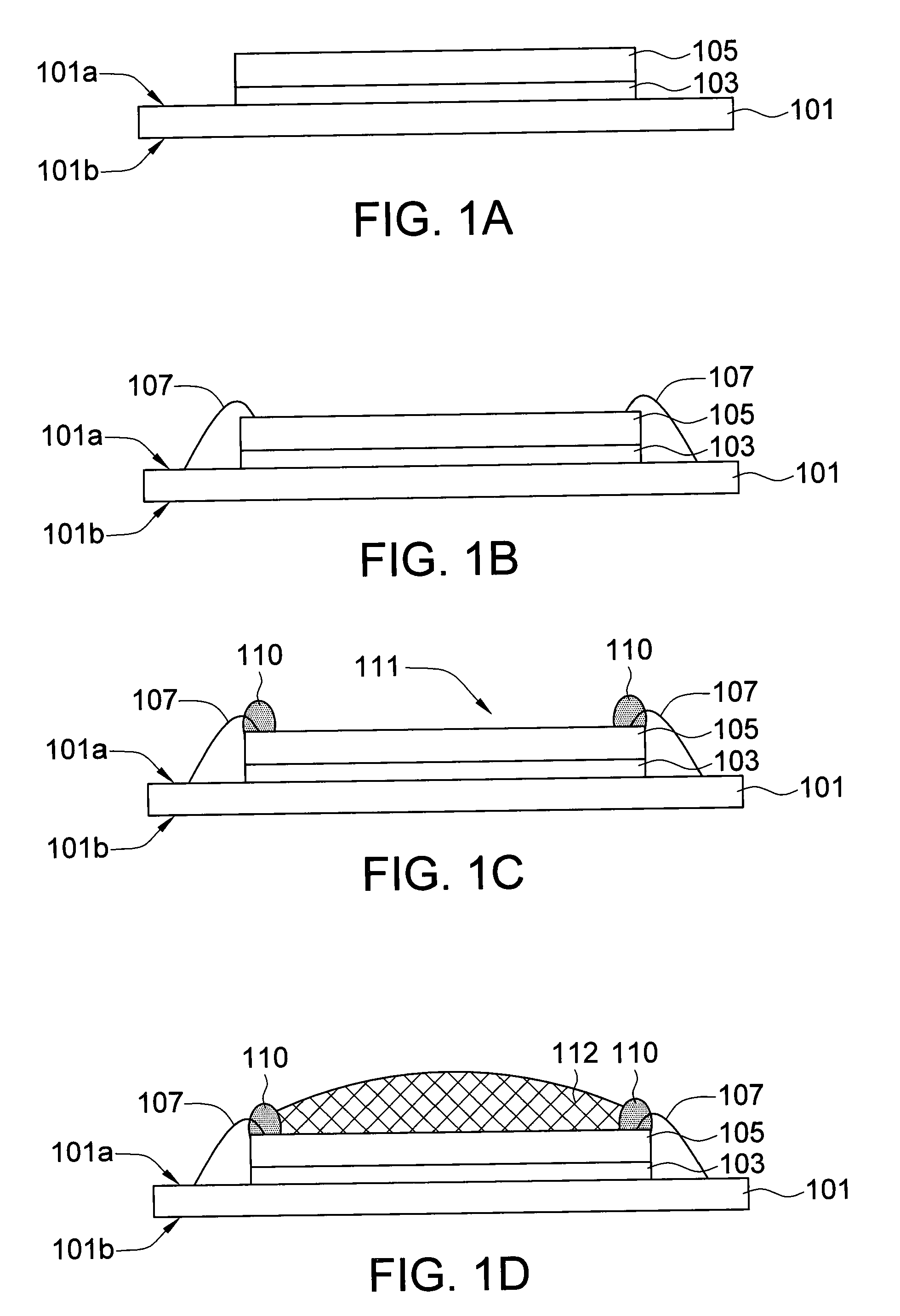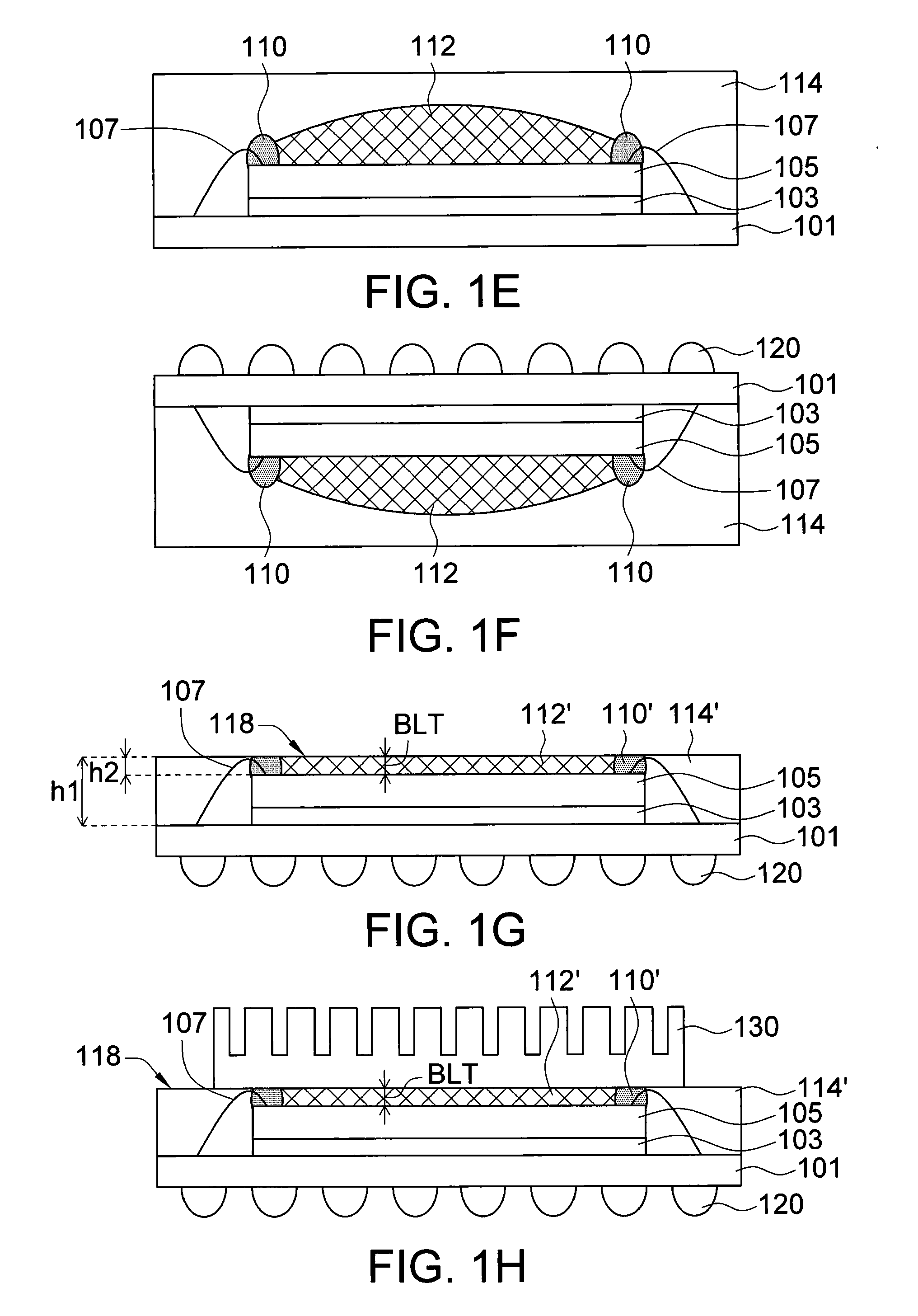Chip scale package and method of fabricating the same
- Summary
- Abstract
- Description
- Claims
- Application Information
AI Technical Summary
Benefits of technology
Problems solved by technology
Method used
Image
Examples
first embodiment
[0023]Referring to FIG. 1A˜FIG. 1H, a method of fabricating a CSP structure according to a first embodiment of the invention is shown. First, a substrate 101 is provided, and an adhesive 103 is used for fixing the rear surface of a chip 105 on the front surface 101a of the substrate 101, as shown in FIG. 1A. Next, a number of wires 107 are used for electrically connecting the front surface (the electrode surface) of the chip 105 with the substrate 101 by way of wire bonding, as shown in FIG. 1B.
[0024]Then, a dam-like non-conductive paste 110 is formed on the front surface of the chip 105, wherein the non-conductive paste 110 further covers the wires 107, as shown in FIG. 1C. The non-conductive paste 110 defines a receiving area 111 on the front surface of the chip 105. The non-conductive paste is made from a non-electrically conductive material such as epoxy or the like.
[0025]Afterwards, a thermal conductive paste 112 is filled within the receiving area 111. Then, a heating step is ...
second embodiment
[0031]Referring to FIG. 2A˜FIG. 2H, a method of fabricating a CSP structure according to a second embodiment of the invention is shown. In the second embodiment, the chip is bonded by way of flip-chip bonding.
[0032]First, a substrate 201 is provided, and conductive bumps such as a tin-lead protrusion 203 is used for flip-bonding the chip 205 on the front surface 201a of the substrate 201 by way of soldering with the front surface (the electrode surface) of the chip 205 facing downward, as shown in FIG. 2A. Compared with the way of wire-bonding, the advantage of using the tin-lead protrusion is that the flip chip package largely increases the density of the input / output (I / O) contacts of the chip. Next, an underfill 207 can be selected and filled between the chip 205 and the substrate 201 as shown in FIG. 2B.
[0033]Then, as shown in FIG. 2C, a thermal conductive paste 212 is disposed on the surface (that is, the rear surface 205b) of the chip 205, and then the thermal conductive paste...
third embodiment
[0037]Referring to FIG. 3A˜FIG. 3I, a method of fabricating a CSP structure according to a third embodiment of the invention is shown. In the third embodiment, the chip is bonded by way of flip-chip bonding. The present embodiment is very similar to the second embodiment except that in the present embodiment, a dam-like non-conductive paste is formed before the thermal conductive paste is used to avoid the thermal conductive paste overflowing. The steps of the third embodiment are disclosed below.
[0038]First, a substrate 301 is provided, and conductive bumps such as a tin-lead protrusion 303 is used for flip-bonding the front surface of (the electrode surface) of the chip 305 on the front surface 301a of the substrate 301, as shown in FIG. 3A. It is noted that the chip 305 could be electrically connected with the substrate 301 other types of conductive materials, and tin-lead is merely exemplified as one material of conductive bumps. Next, an underfill 307 is selected and filed betw...
PUM
 Login to View More
Login to View More Abstract
Description
Claims
Application Information
 Login to View More
Login to View More - R&D
- Intellectual Property
- Life Sciences
- Materials
- Tech Scout
- Unparalleled Data Quality
- Higher Quality Content
- 60% Fewer Hallucinations
Browse by: Latest US Patents, China's latest patents, Technical Efficacy Thesaurus, Application Domain, Technology Topic, Popular Technical Reports.
© 2025 PatSnap. All rights reserved.Legal|Privacy policy|Modern Slavery Act Transparency Statement|Sitemap|About US| Contact US: help@patsnap.com



